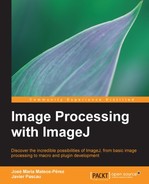Welcome to the first chapter of Image Processing with ImageJ. ImageJ is public domain multi-platform software for image analysis written in the Java programming language. It includes predefined functions for a great variety of common tasks and can be extended easily using macros, scripting in several programming languages (including JavaScript and Python), and Java plugins.
In this brief introduction, you will read what ImageJ is, and how to install it, along with some minor configuration tricks. By the end of this chapter, you will have a working ImageJ installation in your system. Contents of this chapter include:
- A brief description of ImageJ and its main purpose
- An installation and upgrade guide
- How to tweak the amount of memory used by ImageJ, in case you are working with big images
ImageJ's development started as long ago as 1987, when it was not even named ImageJ and Java was yet to be born. That year, Wayne Rasband started coding a piece of software named "NIH Image" (after the National Institute of Health (USA), which funded his efforts) in order to provide a way to perform image analysis on the old Apple Macintosh II, which lacked an image analysis platform, and was starting to be the desktop system of choice for many scientists. He started distributing his software for free to anyone who requested it.
This imaging software became increasingly popular, but at the time the market for Apple computers was being surpassed by the PC. NIH Image was developed specifically for Apple systems and didn't work on the Windows platform. In 1995, the Java programming language was created by Sun Microsystems. This allowed Wayne to start porting his software so it would work on PCs, and at the same time maintain a single, multi-platform version of the source code. ImageJ was born.
During the development process, a great deal of care was taken to allow users to extend ImageJ's native capabilities with the help of macros that can be developed even by users with no prior programming experience; and an open API allowed experienced programmers to code their own plugins. This is one of the reasons for ImageJ's success among scientists that work with images regularly, along with the huge amount of macros and plugins available from the web page. At the time of this writing, the ImageJ's user mailing list had more than 2000 subscribers and is a very active discussion meeting point for everything related to this software and related projects.
